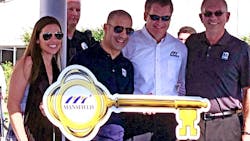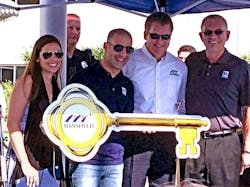Engineering an IndyCar Victory Is More About Data And Simulation Than The Car’s Electronics
With all the electronics that go into today’s passenger vehicles, you may think that IndyCars are enjoying the same flood of new electronic innovations. Not so. In fact, some teams are ratcheting back in favor of a smarter balance between vehicle electronics and the driver. At least that’s what Jimmy Vasser, co-owner of the winning IndyCar at this year’s Indianapolis 500, said at an event held recently at Mouser Electronics headquarters in Mansfield, Texas.
“With all the technologies at the fingertips of young engineers nowadays, you can have full active suspension, full hydraulics and computers—it gets out of control. We’ve been peeling back some of the technology to put the car back into the driver’s hands—there’s not a lot of driver aids anymore,” said Vasser.
He continued by saying that there used to be full traction control and automatic gear boxes and that the driver didn’t have to do much more than point the car in the right direction. In reality, he said, if things continued to go that way you could eliminate the driver altogether and run the race by remote control or even have a computer with GPS drive the car and it would be a complete science project.
Mouser Electronics, a well-known design engineering resource and global distributor for semiconductors and electronic components, sponsors the car built by the KV Racing Technology team, which includes owners Vasser and James “Sulli” Sullivan. The car’s driver is, of course, Tony Kanaan. To celebrate the team’s victory, Mouser invited its employees, the people of Mansfield, and the media to Tony Kanaan Day. Tony arrived in grand style, being whisked to the event by helicopter from Dallas/Fort Worth International Airport and landing on a street adjacent to the Mouser building. A marching band then escorted him to the podium where Glenn Smith, President & CEO of Mouser and David Cook, Mayor of Mansfield, presented him with a key to the city (see photo).
As Kanaan and Vasser talked about the victory and the preparation they went through, it became clear that much of the engineering work was in data collection and analysis as well as simulation. Of course, data collection requires a good deal of electronics such as sensors, transceivers, data acquisition hardware and software and more, while simulation requires sophisticated software and powerful computers. Though Kanaan recognizes the value of collecting data, he said that both data analysis and simulation sometimes take a back seat to driver experience.
“We have one rule on the team, you always trust the driver,” said Kanaan. “The computer should be your backup, should be something to help you. Although we have a very sophisticated system, we have live timing, telemetry and they always know what’s going on in every single part of that car while I’m driving, I still think that some of the data may not be 100% accurate, which is normal.”
Kanaan went on to say that the favorite words from his engineers were “simulation says,” but he countered by saying that they have to listen to what the driver has to say. He said the simulation should be used as a baseline, but ultimately the team always has to listen to the driver.
With huge forearms and a thick neck, it’s easy to understand why an engineer would listen to Kanaan, besides the driving savvy that he brings to the table. But it’s also easy to picture him sitting at the wheel of an IndyCar and enduring 500 grueling miles of a race. When asked about his training regimen, Kanaan said, “Driving is an extremely physical activity. I probably spend three to four hours exercising each day when I’m not on the racetrack, just working out, doing neck and shoulder exercises and other things. Those cars are extremely hard to drive. We don’t have power steering, so the steering is extremely heavy. And being strapped in a race car for three hours is extremely tough.”
So what does it take to win the Indianapolis 500? Certainly it’s a team effort with many players, including the racing team and its sponsors. But apparently, there’s also a delicate balance that must be struck between engineering knowhow and a driver’s knowledge and instinct.
You can view the car and other photos from Tony Kanaan Day at electronicdesign.com.
About the Author
Joe Desposito Blog
Editor-in-chief
Joe Desposito has held the position of editor-in-chief of Electronic Design since July, 2007. He first joined the publication in 1998 as a technology editor covering test and measurement but quickly expanded his coverage areas to include communications and consumer electronics. In May, 2000 Joe moved to sister publication, EE Product News, as editor-in-chief, overseeing the transition of that publication from print to web only and developing e-newsletters and a companion digital publication called eepn2.
Prior to that, Joe worked as a project leader in PC Magazine’s renowned PC Labs and was one of four team members on the original PC Labs staff. In this capacity, he worked to develop the PC Labs benchmark tests for PC hardware and software. Joe holds a BEE from Manhattan College and has written many articles and several books on computers and electronics.

